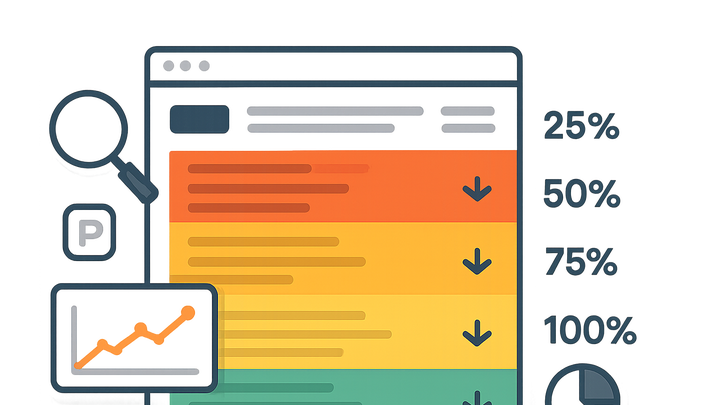Published on 2025-06-29T19:35:54Z
What is Scroll Depth? Examples and Importance for CRO, UX, and SEO
Scroll Depth measures the percentage of a webpage that users view by tracking their scroll position, typically at thresholds like 25%, 50%, 75%, and 100%. This metric is essential for evaluating content visibility, user engagement, and the effectiveness of calls to action in the context of CRO (Conversion Rate Optimization), UX (User Experience), and SEO (Search Engine Optimization). By understanding how deep visitors scroll, you can identify where users lose interest and prioritize content, design, and layout improvements. Tools like Prevue.me integrate scroll depth analysis into actionable critiques, combining CRO, UX, SEO, and accessibility insights. These critiques help you pinpoint underperforming sections, reposition key messages and CTAs, and ultimately boost lead generation and organic performance.
Scroll depth
Scroll Depth measures how far users scroll on a page, revealing engagement and content visibility to optimize CRO, UX, and SEO.
Understanding Scroll Depth
An overview of what scroll depth is and why it matters for engagement and optimization.
-
Definition and key metrics
Scroll depth refers to the percentage of a webpage users scroll before leaving. It’s tracked at common thresholds—25%, 50%, 75%, and 100%—to quantify user engagement and content visibility.
-
Importance for cro, ux, and seo
Scroll depth indicates whether visitors reach critical content and calls to action, informing CRO strategies. It highlights UX friction points where layout or design may impede discovery. In SEO, deeper scroll engagement correlates with lower bounce rates and signals content quality to search engines.
Measuring Scroll Depth
Methods and tools to implement scroll depth tracking effectively.
-
Analytics tools and plugins
Popular platforms like Google Analytics, Mixpanel, and prevue.me offer built-in scroll depth tracking. prevue.me enhances this by providing actionable CRO, UX, SEO, and accessibility critiques based on scroll behavior.
-
Implementation steps
- Add a scroll-tracking script or use Google Tag Manager.
- Define scroll thresholds (25%, 50%, 75%, 100%) and set up events.
- Ensure consistent event naming for clear reporting.
Analyzing Scroll Depth Data
How to interpret scroll metrics and apply insights to improve site performance.
-
Identifying drop-off points
Locate thresholds where engagement sharply declines to discover content or design issues. Review the surrounding page elements—such as large images or dense text—to optimize or restructure.
-
Segmentation and comparison
Break down data by device type, traffic source, or user segment to detect behavioral differences. Compare scroll depth before and after experiments to measure the impact of design or content changes.
Optimizing Based on Scroll Depth Insights
Actionable strategies to enhance scroll engagement and conversions.
-
Content and layout enhancements
If users drop off early, move headlines, key messages, and CTAs closer to the top. Use visuals, subheadings, and bullet points to break up text and maintain interest.
-
A/b testing strategies
Run split tests with different layouts, content lengths, and multimedia placements. Monitor scroll depth alongside conversion metrics to identify the most effective variations.
Practical Example: Using Prevue.me
A step-by-step use case demonstrating scroll depth analysis with prevue.me.
-
Setup and data collection
In prevue.me, enable scroll depth tracking for priority pages. The platform automatically gathers data and integrates it into a unified CRO report.
-
Actionable critiques
prevue.me analyzes scroll patterns to pinpoint underperforming sections. It generates UX and SEO recommendations—like repositioning CTAs or adding visuals—to improve lead generation and engagement.
